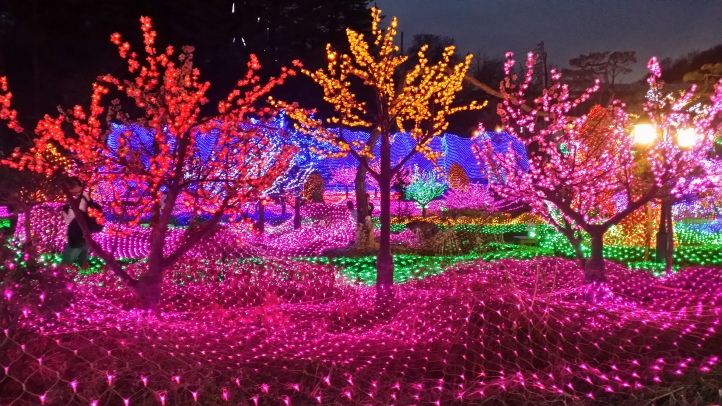One popular theme in Korean TV dramas is travelling to the past. While we do not have the time machine to help us do so, there are some good places in Seoul where you can experience and learn about the past Korea through different means. In fact, the history is an important part of a country’s culture, and if you are interested in Korean culture, it is worthwhile to go to these places to learn more about the Korean history.
National Museum of Korea (국립중앙박물관)
This is one of my favourite places – I often went to this museum when studying Korean in Seoul. The National Museum of Korea is a world-class museum with over 12,000 artifacts from the Paleolithic era to Goryeo, Joseon and modern periods on display. Many of these are designated as Korean national treasures, e.g., Pensive Bodhisattva (Korean National Treasure No.83), Goryeo Celadon Openwork Incense Burner (No.95), Ten-Story Stone Pagoda from Gyeongcheonsa Temple-Site (No.86), and Gold Crown from Silla (No.191).
On the first floor, the “Prehistory and Ancient History” section displays artifacts from the earliest period of Korean civilization and culture. The “Medieval and Early Modern History ” section displays artifacts from the Goryeo Dynasty (918-1392), the Joseon Dynasty (1392-1897), and the Korean Empire (1897-1910), the three most significant periods in the Korean history.
On the second floor, there are the “Calligraphy and Painting” section displaying traditional Korean paintings, Buddhist paintings, and calligraphy pieces, and the “Donated Works” section displaying artifacts donated by individual collectors.
On the third floor, the “Sculpture and Crafts” section displays artifacts of Buddhist sculpture, metal arts, and ceramics, and the “Asian Arts” section displays cultural assets from China, Japan and Central Asia.
In addition, inside the Children’s Museum, the kids can play with blocks, try putting together artifact picture puzzles, and learn about how people lived in ancient times in the exhibition room and the children’s library.
As there are indeed a lot of valuable artifacts in this museum, if you need any guidance in walking around the museum, you may join the guided tours for foreigners available in English, Chinese, Japanese and French at designated times. These guided tours introduce the representative artifacts of the Permanent Exhibition and help you better understand the stories behind them. Alternatively, you may rent the digital (PDA) or audio (MP3) tour guides available in Korean, English, Chinese, and Japanese which provide information on the exhibits and the viewing routes. There are also restaurants and cafes inside the museum so you may be able to spend a whole day there without the need to go out for meals.
Let’s have a glimpse of the National Museum of Korea and some of its valuable artifacts by watching this video.
National Folk Museum of Korea (국립민속박물관) and National Palace Museum of Korea (국립고궁박물관)
These two museums are both located inside the Gyeongbokgung Palace (경복궁) but display items that represent the traditional life and culture of two very different classes of people in the past. The National Folk Museum of Korea displays folklike artifacts that were used in the daily lives of the commoners, e.g., farming tools, wooden kimchi jar, clothes worn by the brides, etc. whereas the National Palace Museum of Korea exhibits elegant artifacts from the royal families of the Joseon era relating to the royal symbols and records, royal ancestral rites, and the daily lives of the royal families.
You can have a quick tour of both museums by clicking the following links:
National Folk Museum of Korea tour
National Palace Museum of Korea tour
War Memorial of Korea (전쟁기념관)
If you want to know more about the Korean war history or are interested in military weapons, this is a must-go place for you. The War Memorial of Korea was built to commemorate the patriots who sacrificed their lives in wars and serves as a national educational venue for Koreans. It offers exhibitions relating to the memory of the patriotic martyrs, the Korean war history from the prehistoric period to the Japanese colonial period, the Korean War, and activities of Korean troops despatched to overseas to engage in wars like the Vietnam War and the Gulf War. There are also exhibitions of replicas of state-of-art weapons produced by Korean companies and military equipment (including tanks, fighter jets and warships) used in past wars.
You can have a glimpse of the War Memorial of Korea by watching this video.
Seodaemum Prison History Hall (서대문형무소역사관)
The Seodaemum Prison was originally used to confine, torture and execute the Korean independence activists who fought against the Japanese during the Japanese colonial period and was later used to imprison the democratic activists until 1987. It symbolizes the history of the freedom fighters in modern Korean history. The place was converted into the Seodaemum Prison History Hall to commemorate the freedom fighters and teach the people to honour the spirit of independence, freedom and peace. Apart from the jail cells, the historical exhibition hall and the execution room, you may also see the recreated torture scenes which are pretty frightening.
You can have a quick tour of the Seodaemum Prison History Hall by watching this video.
Next time you visit Seoul, please don’t forget to visit the above places to experience and learn about the past Korea. This may help you get a better understanding of the Korean culture.
Reminder: You can follow my blog by clicking the “Follow” button on the sidebar to receive email notifications of new posts. For flash news on Korean culture, you can also follow me on Twitter (Kalbi8888).
References:
Seoul Best 100, Seoul Metropolitan Government, December 2016
Seoul: A Fun Vacation for the Whole Family, Seoul Metropolitan Government, December 2016

Love all these! I also like the National Museum of Korean Contemporary History (newer but still old^^)
LikeLike
Thanks for sharing. Yes, the National Museum of Korean Contemporary History is good too – a must-go place for people interested in Korean modern history.
Cheers
Kalbi
LikeLiked by 1 person